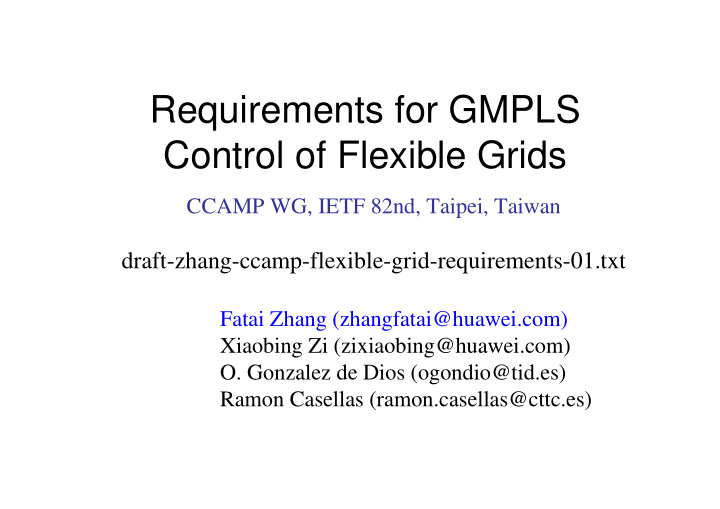



Requirements for GMPLS Control of Flexible Grids CCAMP WG, IETF 82nd, Taipei, Taiwan draft-zhang-ccamp-flexible-grid-requirements-01.txt Fatai Zhang (zhangfatai@huawei.com) Xiaobing Zi (zixiaobing@huawei.com) O. Gonzalez de Dios (ogondio@tid.es) Ramon Casellas (ramon.casellas@cttc.es)
Contents • What is Flexi-Grid? • Impacts on WSON by Flexi-Grid • Routing and Spectrum Assignment (RSA) models • Requirements of GMPLS Control
What is Flexi-Grid? (1) � Introduced in the draft revised version of [G.694.1] , which is planned to be consented in December SG15 plenary meeting. � Enabling different passbands (slot widths) on a single fibre. In this way, � It will be possible to offer in the future a mixture of several bitrates on a single fibre, each with its own passband. � It will be possible to increase the spectral efficiency on a fibre. With the current fixed grid it is only “possible” to use a width of 12.5GHz, 25GHz, 50GHz and 100GHz. For future bitrates of e.g. 400Gbit/s it would be advantageous to permit slot widths somewhere in between 50GHz and 100GHz.
What is Flexi-Grid? (2) 193.1 THz … ... -9 -8 -7 -6 -5 -4 -3 -2 -1 0 1 2 3 4 5 6 7 8 9 DWDM link Frequency slot 1: Frequency slot 2: Central frequency = 193.1 + 0.00625*(-5) Central frequency = 193.1 + 0.00625*(4) = 193.06875 THz = 193.125 THz Slot width = 0.0125*3 = 0.0375 THz Slot width = 0.0125*4 = 0.05 THz Flexi-Grid: a new WDM frequency grid defined with the aim of allowing flexible optical spectrum management, in which the Slot Width of the frequency ranges allocated to different channels are flexible (variable sized). Frequency Slot: The frequency range allocated to a channel and unavailable to other channels within a flexible grid. A frequency slot is defined by its nominal central frequency and its slot width . Central Frequency = 193.1 THz + n * 0.00625 THz Slot Width : the full width (in Hz) of a frequency slot, a multiple (m) of 12.5 GHz.
Impacts on WSON: Flexible Grid Specific Info. DWDM link 2 DWDM link 1 Node A2 D3 A1 A3 D1 D2 DWDM Links: The available frequency ranges MUST be known to perform Spectrum Assignment (SA) procedure, because the resource allocated to a flexi-LSP is a frequency range on each DWDM link. ADD/DROP Interfaces: The available central frequencies and slot width requirement MUST be known to perform Spectrum Assignment (SA) procedure. The central frequency of a ADD/DROP interface could be fixed or tunable.
RSA Models Computation Element 1 Computation Element Routing Routing Routing SA SA SA A Single Computation Element Computation Element 2 Signaling Procedure Combined RSA Separated RSA Routing and Distributed SA Only the route is determined before Both of the route and frequency slot are determined before the signaling the signaling procedure, frequency procedure slot is allocated by the signaling procedure In all cases, the computation element(s) could reside on PCE(s) or ingress nodes. Routing and Spectrum Assignment (RSA): Compute a route and assign a frequency slot for a flexi-LSP.
Example – Combined RSA PCE 1. PCReq: (END-POINTS: AD1-AD2; Constraints: slot width, …) 2. PCRep: (route, frequency slot) AD1 IF2 IF3 IF4 AD2 IF1 A B C DWDM link DWDM link 3. Path: (route, frequency slot…) 4. Path: (route, frequency slot…) 5. Resv 6. Resv Note: The frequency slot cross-connect for this flexi-LSP can be created at Path or Resv stage.
Example – Distributed RSA AD2 AD1 IF2 IF3 IF4 IF1 A B C DWDM link DWDM link 1. Compute a route, select the 2. Path: (route, slot width, central available central frequencies frequencies set…) that meet the slot width 3. Path: (route, slot width, requirement of the LSP 4. Select an available central updated central frequencies set…) frequency and build the corresponding frequency slot cross-connect between AD2 and IF4 5. Resv: (frequency slot…) 8. Build the frequency slot 6. Build the frequency slot cross- cross-connect between AD1 7. Resv: (frequency slot…) connect between IF2 and IF3 and IF1
GMPLS Requirements for Flexi-Grid Control � Routing Aspects: � WSON related information (except wavelength availability) (See Section 6.2 of RFC6163) � Eg. connectivity matrix, signal compatibility and processing… � Available Frequency Ranges of each link (Link information) � Signaling Aspects: � WSON signaling reqs (except Identifying Wavelengths) (See Section 6.1 of RFC6163) � Eg. Signal compatibility information (FEC, Modulation, OEO…) � Identifying the Slot Width Requirement � Identifying the Central Frequency assigned to a LSP � PCE Aspects: � Depends on the RSA models � Signal compatibility constraints � Frequency Constraints (slot width, Available central frequencies)
Open Issue: Contiguous vs non-contiguous • Whether flexi-grid can support non-contiguous frequencies? (ie., can a flexi-LSP use some non-contiguous frequencies on a link? – This responsibility is in the scope of ITU-T SG15. – The latest revised version of [G.694.1] can not support that.
Next Steps •Monitor the progress of ITU-T work •Refine it according to the feedback from the meeting or mailing list
Recommend
More recommend